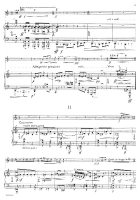Two Caprices for clarinet and piano (1953)
The piece is a miniature which is a direct reference to the form of the 19th century caprice, combining virtuoso and lyrical elements. The composer used traditional elements in the melody of the solo voice, shaping it on the basis of pentatonic, Doric gestures, but also using major and minor scale runs. In the thematic material he drew on the Concerto for Orchestra (movements II and IV). The accompaniment adds a note of the grotesque to the piece, primarily thanks to a uniform rhythmic pattern enriched by the staccato articulation and the secco indication. The harmony is based on shifts of fourth chords wandering in search of a point of reference. It comes only at the end of each caprice, as an equivocally presented chord: C minor (I. Poco vicace, grazioso) and E major (II. Con moto).
The piece won the composer the 2nd prize at a Polish Composers’ Union competition for concert and chamber pieces (1953).






